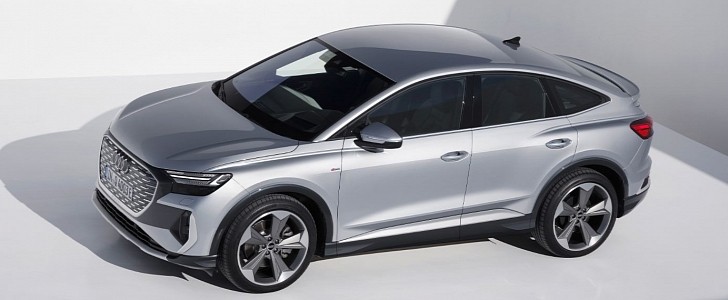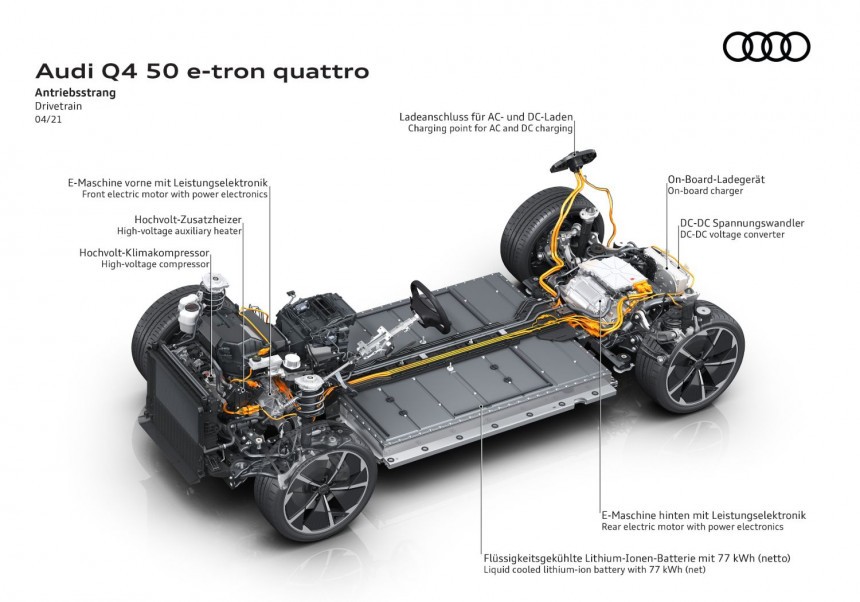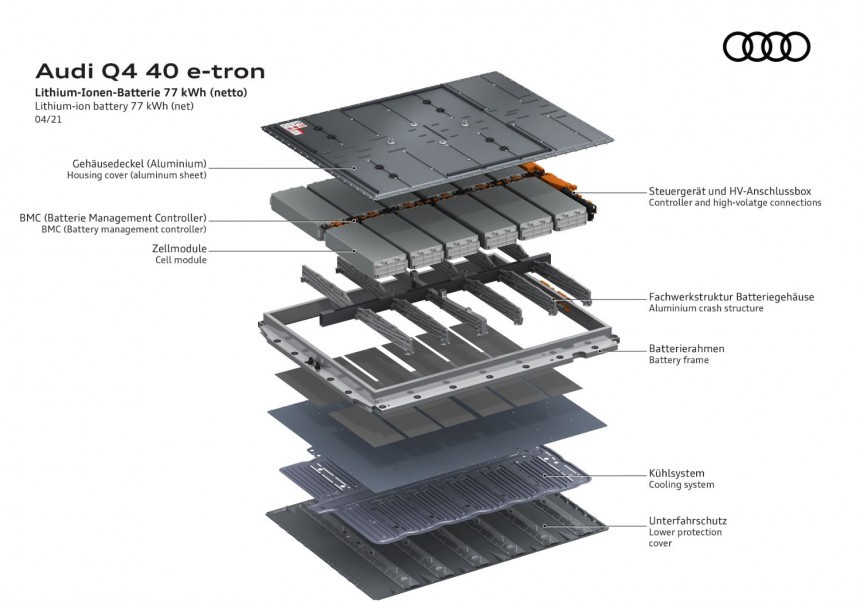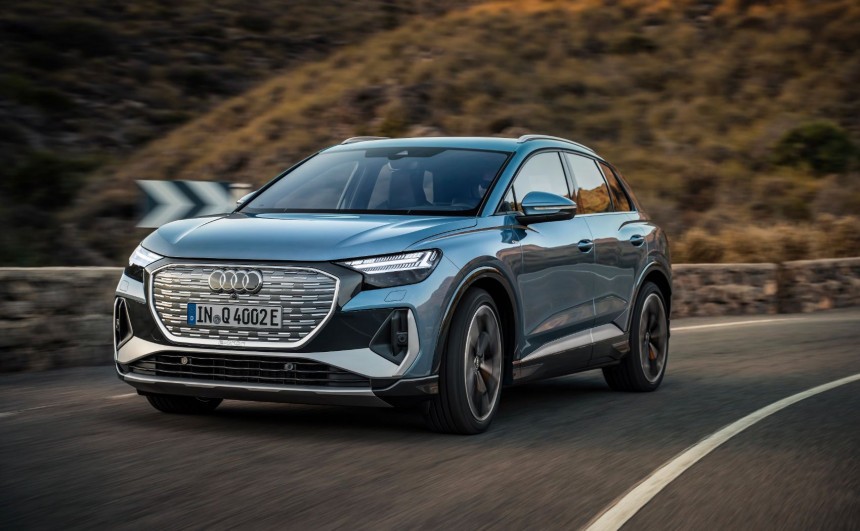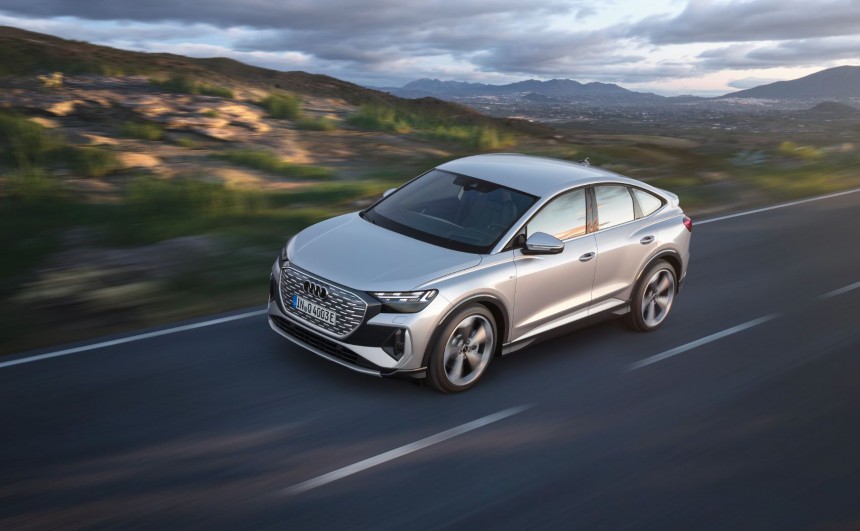After announcing that it will stop further development of ICEs, Audi continues its EV offensive. The latest members of its zero-emissions lineup are the Q4 e-tron and its Sportback sibling. Although they feature a different rear end, the compact crossover SUVs share the same powertrains. This article takes a look at each configuration and explores the technologies behind the motors and battery packs.
The German manufacturer has recently revealed the final production versions of the Q4 and Q4 e-tron models, two all-electric alternatives for the ICE-powered Q5. They’re nearly identical in every way, but just like other SUVs in Audi’s portfolio, the Sportback variant offers a different rear-end design for those who prefer a more aggressive, coupe-like look.
The underpinnings are obviously the same, utilizing Volkswagen Group’s MEB platform developed exclusively for EVs and shared with the VW ID.3, ID.4, and Skoda Enyaq.
Both EVs will be available in entry-level RWD versions called 35 e-tron or long-range, quattro AWD models marketed under the 50 e-tron moniker. Additionally, a mid-range RWD 40 e-tron trim will also be available but only for the standard-bodied Q4.
All aforementioned versions feature a water-cooled APP 310 permanent magnet synchronous motor that drives the rear wheels and can rev up to 16,000 rpm. The APP designation is derived from the arrangement of the drive unit in parallel with the axle, while the three digits come from the 310 Nm (229 lb-ft) of torque it develops.
Including the power electronics and the integrated single-speed transmission, the whole assembly weighs around 198.5 pounds (90 kg). If all this sounds familiar, it’s because the same electric drive is used on the VW ID.3 and ID.4.
In addition to the rear-mounted APP 310 unit, the sporty, range-topping 50 e-tron quattro Q4s are equipped with an asynchronous motor installed coaxially and cooled by a mix of coolant and oil. It provides power to the front wheels with a limit of close to 14,000 rpm, and like the one on the rear axle, it also includes a single-speed transmission.
The all-electric quattro system only utilizes the rear motor to supply power to the rear wheels and it only engages the front unit when the vehicle loses traction.
The entry-level models mentioned earlier will get their power from a compact, eight-module 350-kilogram (772-pound) battery pack with a net energy content of 52 kWh.
On the 40 e-tron and 50 e-tron quattro SUVs, the pack weighs 1,102 pounds (500 kg) and contains four additional modules that increase the net energy content to 77 kWh.
Both lithium-ion packs feature an aluminum housing permanently bolted to the body of the vehicles to improve overall rigidity. They are enclosed in a specifically developed crash protection frame made from the same corrosion-resistant material.
Two coolant circuits comprise the thermal management system of each pack. One of them controls the temperature of the motors, their power electronics, the onboard charger, and the DC/DC converter, while the other only regulates the battery's temperature.
In terms of performance, Q4 35 e-tron SUV can produce 125 kW (170 PS/168 hp) regardless of the body style, whereas the Q4 40 e-tron surpasses that by 25 kW (34 PS/33.5 hp). With the first configuration, the vehicles can reach 62 mph (100 kph) from a standstill in a modest 9 seconds, whereas the 40 e-tron improves by half of a second.
The dual-motor 50 e-tron quattro models are a different story. They generate a combined output of 220 kW (299 PS/295 hp) and can sprint from 0 to 62 mph in a decent 6.2 seconds.
According to the WLTP cycle, the Q4 35 e-tron can cover up to 212 miles (341 km) on a single battery charge. Those who chose the Sportback variant should get 5 extra miles (8 km). Additionally, the 40 e-tron’s bigger battery extends the range to 323 miles (520 km).
Also, depending on the body style, the quattro models have ranges of up to 303 miles (488 km) and 309 miles (497 km) respectively.
Audi’s new all-electric, compact SUV will be available in dealerships by the end of the year. We don’t have any official prices yet, but we expect it to command anywhere between $40,000 and $60,000, depending on the version and optional extras.
As you can see, there’s nothing particularly revolutionary about the powertrains, but for a luxury EV in this segment and price range, they are more than adequate.
Yes, the lower and mid-range models are ID.4’s in designer clothing, but the quattro models add more power, range, as well as all-wheel-drive.
The underpinnings are obviously the same, utilizing Volkswagen Group’s MEB platform developed exclusively for EVs and shared with the VW ID.3, ID.4, and Skoda Enyaq.
Both EVs will be available in entry-level RWD versions called 35 e-tron or long-range, quattro AWD models marketed under the 50 e-tron moniker. Additionally, a mid-range RWD 40 e-tron trim will also be available but only for the standard-bodied Q4.
Electric Drive Units
Including the power electronics and the integrated single-speed transmission, the whole assembly weighs around 198.5 pounds (90 kg). If all this sounds familiar, it’s because the same electric drive is used on the VW ID.3 and ID.4.
In addition to the rear-mounted APP 310 unit, the sporty, range-topping 50 e-tron quattro Q4s are equipped with an asynchronous motor installed coaxially and cooled by a mix of coolant and oil. It provides power to the front wheels with a limit of close to 14,000 rpm, and like the one on the rear axle, it also includes a single-speed transmission.
The all-electric quattro system only utilizes the rear motor to supply power to the rear wheels and it only engages the front unit when the vehicle loses traction.
Battery Packs
On the 40 e-tron and 50 e-tron quattro SUVs, the pack weighs 1,102 pounds (500 kg) and contains four additional modules that increase the net energy content to 77 kWh.
Both lithium-ion packs feature an aluminum housing permanently bolted to the body of the vehicles to improve overall rigidity. They are enclosed in a specifically developed crash protection frame made from the same corrosion-resistant material.
Two coolant circuits comprise the thermal management system of each pack. One of them controls the temperature of the motors, their power electronics, the onboard charger, and the DC/DC converter, while the other only regulates the battery's temperature.
Performance and Range
The dual-motor 50 e-tron quattro models are a different story. They generate a combined output of 220 kW (299 PS/295 hp) and can sprint from 0 to 62 mph in a decent 6.2 seconds.
According to the WLTP cycle, the Q4 35 e-tron can cover up to 212 miles (341 km) on a single battery charge. Those who chose the Sportback variant should get 5 extra miles (8 km). Additionally, the 40 e-tron’s bigger battery extends the range to 323 miles (520 km).
Audi’s new all-electric, compact SUV will be available in dealerships by the end of the year. We don’t have any official prices yet, but we expect it to command anywhere between $40,000 and $60,000, depending on the version and optional extras.
As you can see, there’s nothing particularly revolutionary about the powertrains, but for a luxury EV in this segment and price range, they are more than adequate.
Yes, the lower and mid-range models are ID.4’s in designer clothing, but the quattro models add more power, range, as well as all-wheel-drive.
